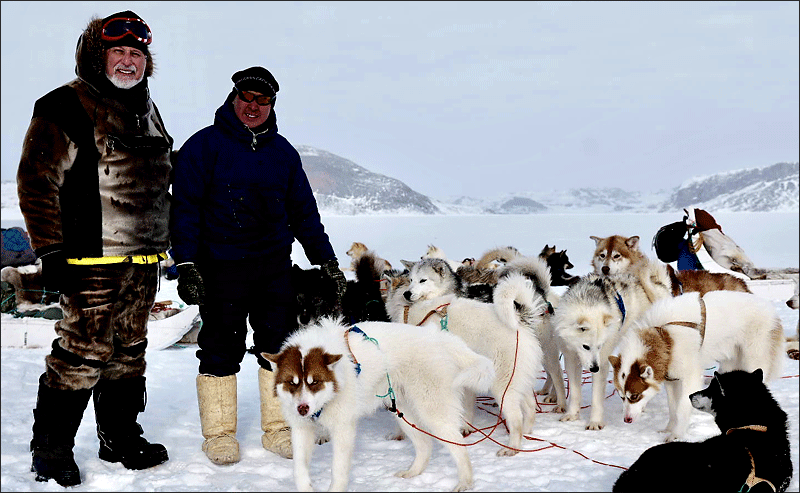“Uggianaqtuq” (Strange Weather in Inuit)
Uggianaqtuq. Pronounced “OOG-e-ah-nak-tuk”, it is the Inuit word meaning weather behaving strangely. I think of the word often in these times of record-setting high temperatures, and think back fondly to when I first met the Inuit some 35 years ago. They are the historically nomadic people of the Arctic, some 150,000 people living in Alaska, Canada, Greenland, and Scandinavia. (Btw, they largely reject the ethnic term Eskimo.)
I first heard uggianaqtuq on my initial visit to the high Arctic in 1985. We were doing a diving expedition under the polar ice on Jones Sound, carrying a flag for the Explorers Club. With our train of six snowmobiles and sleds for our equipment, we relied on our expert Inuit guides to “read the ice” to find our way on the vast white ice sheet covering Jones Sound. Suddenly we lost a snowmobile through the ice into the dark icy waters. We retrieved it, but the immersion in saltwater meant it was inoperable and would become another piece of heavy equipment to carry to our destination, Ellesmere Island.
The Inuit kept muttering uggianaqtuq.
They were a bit embarrassed this happened. They were perplexed by the thinness of the ice, strange and unusual to them for that area at that time of year. The weather was not normal. It was inexplicable. They could not have known it then, but this was one of the early signs of a warming world.
Presently, in our part of the world, far below the Arctic Circle, the horrific heatwave has been making weekly headlines. From the Pacific Northwest to Europe, temperatures above 50 degrees Centigrade (120 Fahrenheit) are unprecedented in the century and a half of weather records. Last week, Seattle was warmer than Miami. We are breaking all records.
This cannot be explained directly by global warming of just over a degree Celsius. However, it can be explained by the errant jet stream behavior producing “blocking pattern” weather systems, in this case a heat dome that stayed in place long enough for temperatures to rise to record extremes. The disruption to the jet stream directly relates to the thawing polar ice cap.
To put this in context, for a few million years, the Arctic Ocean was frozen year round, with typical ice thickness of some three meters, or ten feet. That thick ice served as a heat barrier, similar to the function of a window in a building. As satellite images clearly document, the polar ice cap is rapidly disappearing, greatly increasing the amount of heat the ocean absorbs from the atmosphere at times, and then releasing back to the atmosphere at other.
It is this increased transfer of heat between atmosphere and ocean that is disrupting the normal seasonal pattern and location of the Jet Stream. The modified jet stream creates heat-blocking air masses that cause extreme temperatures. The extreme heat causes direct human fatalities, rampant wildfires, and faster melting of the polar ice cap. The melting ice cap then accelerates the process of ocean warming.
This amplifying domino effect of a warming planet is exactly what climate scientists like Dr. James Hansen have been predicting since the early 1980’s.
The melting Arctic Ocean will be particularly difficult for the Inuit, but the problem is not limited to them. The coastlines of 140 nations will be altered by rising sea level. Everything is connected. Warmer temperatures will bring rain, drought, heatwaves and wildfires to every part of the planet.
Even a total switch to renewable energy will not return us to the stable climate of the past few millennia. We have warmed the ocean. At this point we need to deal with this new era with three simultaneous efforts ASAP.
- We must work to slow the warming.
- We must design and engineer for greater resilience.
- We must adapt to certain inevitabilities such as rising sea level.
This quote that I use to open my book, Moving to Higher Ground: Rising Sea Level and the Path Forward, is apt:
“Owing to past neglect, in the face of the plainest warning, we have entered upon a period of danger….The era of procrastination, of half measures, of soothing and baffling expedients, of delays, is coming to its close. In its place we are entering a period of consequences…We cannot avoid this period; we are in it now.” – Winston Churchill
NEW – ONE WEEK “FLASH SALE” – EBOOK ONLY .99, AUDiOBOOK $ 1.99
Tuesday, 7/13 thru Tuesday, 7/20
In order to reach as broad an audience as possible, we are offering a ONE WEEK EBOOK SALE on Amazon.
EBOOK: JUST 99 CENTS! One Week Only
ORDER eBook on Amazon (click here)
AUDIOBOOK: JUST $ 1.99! One Week Only!!
ORDER Audiobook on APPLE (click here)
ORDER Audiobook on GOOGLE PLAY (click here)
NEW Web Site: CLIMATE CHANGE RESOURCES
There is an awesome new website for folks interested in the latest news and developments in the field of climate change. It’s called ClimateChangeResources.org and features an unbelievable wealth of education and action resources with one goal in mind: increasing awareness of the critical role climate plays in our lives.
It is THE go-to website for all things climate, and we will regularly feature some of their news and action steps here in our newsletter. This month CCR focuses on “…HEAT and all its ramifications” as the lead topic in their news section.
Regular areas of coverage include News, Blogs, Educational stories about all aspects of climate, special ways to take action for change, Youth Climate Info and FAQs.



